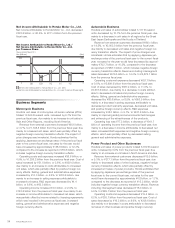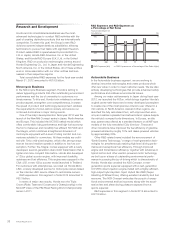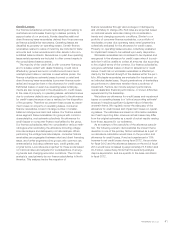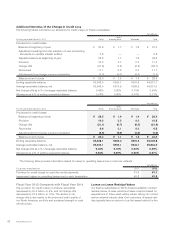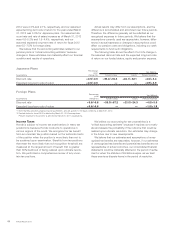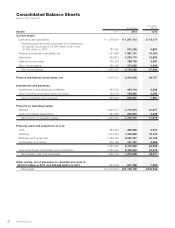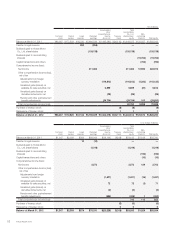Honda 2012 Annual Report Download - page 45
Download and view the complete annual report
Please find page 45 of the 2012 Honda annual report below. You can navigate through the pages in the report by either clicking on the pages listed below, or by using the keyword search tool below to find specific information within the annual report.contractual residual value of the vehicle or to return the vehi-
cle to our finance subsidiaries through the dealer at the end
of the lease term. Likewise, dealers have the option to buy
the vehicle returned by the customer or to return the vehicle
to our finance subsidiaries. The likelihood that the leased
vehicle will be purchased varies depending on the difference
between the contractual residual value and the actual market
value of the vehicle at the end of the lease term. We are
exposed to risk of loss on the disposition of returned lease
vehicles when the proceeds from the sale of the vehicles are
less than the contractual residual values at the end of the
lease term. For direct financing leases, our finance subsidiar-
ies in North America purchase insurance to cover a portion of
the estimated residual value.
We periodically review the estimate of residual values. For
vehicle leases accounted for as operating leases, the adjust-
ments to estimated residual values result in changes to the
remaining depreciation expense to be recognized prospectively
on a straight-line basis over the remaining term of the lease.
For vehicle leases accounted for as direct financing leases,
downward adjustments are made for declines in estimated
residual values that are deemed to be other-than-temporary.
The adjustments on the uninsured portion of the vehicle’s
residual value are recognized as a loss in the period in which
the estimate changed.
The primary components in estimating losses on lease
residual values are the expected frequency of returns, or the
percentage of leased vehicles we expect to be returned by
customers at the end of the lease term, and the expected
loss severity, or the expected difference between the residual
value and the amount we receive through sales of returned
vehicles plus proceeds from insurance, if any. We estimate
losses on lease residual values by evaluating several different
factors, including trends in historical and projected used
vehicle values and general economic measures.
We also test our operating leases for impairment whenever
events or changes in circumstances indicate that their carry-
ing values may not be recoverable.
Recoverability of operating leases to be held is measured
by a comparison of the carrying amount of operating leases
to future net cash flows (undiscounted and without interest
charges) expected to be generated by the operating leases.
If such operating leases are considered to be impaired,
impairment losses to be recognized is measured by the
amount by which the carrying amount of the operating leases
exceeds the estimated fair value of the operating leases.
We believe that our estimated losses on lease residual
values and impairment losses is a “critical accounting esti-
mate” because it is highly susceptible to market volatility and
requires us to make assumptions about future economic
trends and lease residual values, which are inherently uncertain.
We believe that the assumptions used are appropriate.
However actual losses incurred may differ from original
estimates as a result of actual results varying from those
assumed in our estimates.
If future auction values for all Honda and Acura vehicles in
our North American operating lease portfolio as of March 31,
2012, were to decrease by approximately ¥10,000 per unit
from our present estimates, holding all other assumption
constant, the total impact would be an increase in deprecia-
tion expense by approximately ¥1.3 billion, which would be
recognized over the remaining lease terms. Similarly, if future
return rates for our existing portfolio of all Honda and Acura
vehicles were to increase by one percentage point from our
present estimates, the total impact would be an increase in
depreciation expense by approximately ¥0.2 billion, which
would be recognized over the remaining lease terms. With
the same prerequisites shown above, if future auction values
in our North American direct financing lease portfolio were to
decrease by approximately ¥10,000 per unit from our present
estimates, the total impact would be an increase in losses on
lease residual values by approximately ¥0.3 billion. And if
future return rates were to increase by one percentage point
from our present estimates, the total impact would be slight.
Note that this sensitivity analysis may be asymmetric, and are
specific to the base conditions in fiscal 2012. Also, declines
in auction values are likely to have a negative effect on return
rates which could affect the sensitivities.
Fiscal Year 2012 Compared with Fiscal Year 2011
Used vehicle prices remained strong during fiscal year 2012.
Disruptions in the supply of new vehicles caused by the natu-
ral disasters in Japan and Thailand supported the demand for
used vehicles. Losses related to lease residual value of our
finance subsidiaries in North America declined for higher
estimates of lease residual values. No impairment losses as a
result of declines in estimated residual values were recog-
nized during fiscal year 2012.
Incremental depreciation on operating leases declined by
¥2.1 billion, or 81%. Losses on lease residual values on direct
financing leases declined by ¥1.7 billion, or 56%.
Pension and Other Postretirement Benefits
We have various pension plans covering substantially all of
our employees in Japan and certain employees in foreign
countries. Benefit obligations and pension costs are based
on assumptions of many factors, including the discount rate,
the rate of salary increase and the expected long-term rate of
return on plan assets. The discount rate is determined mainly
based on the rates of high quality corporate bonds currently
available and expected to be available during the period to
maturity of the defined benefit pension plans. The salary
increase assumptions reflect our actual experience as well as
near-term outlook. Honda determines the expected long-term
rate of return based on the investment policies. Honda con-
siders the eligible investment assets under investment poli-
cies, historical experience, expected long-term rate of return
under the investing environment and the long-term target
allocations of the various asset categories. Our assumed
discount rate and rate of salary increase as of March 31,
Honda Motor Co., Ltd. 43



